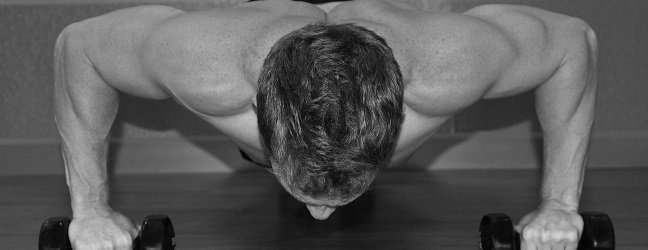
Don’t Make These At-Home Workout Mistakes
Proper form is a must because it can help prevent injury that can seriously sidetrack your results. Check out this expert’s breakdown on how to avoid injury when doing a simple at-home workout that includes squats, dips, and push-ups! This is a MUST read!
At-Home Workout: It’s all about form
Working out at home is and excellent way to make scheduling your workouts easier, as well as lightening the financial burden of a costly gym membership.
However, just because you may not be using heavyweights or machines, doesn’t mean that injury cannot easily ensue. Some great exercises that we do at home can be the culprits in causing pain, discomfort, and a reduction in function.
These three most common exercises that we see regularly that may need slight modification are:
- The Bench Dip
- The Push-Up
- The Squat

The Bench Dip
Dip exercises, or any one of its variations, are truly one of the best and most functional weight training techniques out there. The movement is excellent for targeting some of the larger upper-body muscles, which include the triceps, shoulders, and pectorals muscles.
We use this dip movement pattern all the time in our daily lives, such as when we push doors open, get up out of a seat, or even get up off the floor.
The caveat is the bench dip exercise is the amount of descent that is performed. For a while, people thought that the deeper you go in the exercise, the more stretch, and ultimately better gains, there was for the muscle.
However, today’s research shows us the same amount of gains are derived without the increased descent needed.
Furthermore, the lower one goes in the dip exercise the more stress and strain are placed on the long head of the biceps, as well as undue stress on the rotator cuff.
The safer method is to lower your body until the elbow bends to a little bit less than 90 degrees, then push up to full extension.
The Push-Up
Another pressing or pushing exercise that gets a lot of press and is ideal for both the upper and lower body as well as the core is known as the Push-Up.
The push-up is one of the oldest bodyweight exercises in history. It dates back to the early 1900s and is widely used in both phys ed and military programs throughout the world.
Also known as the press-up, the push-up has been known to not only work the pectorals, deltoids, and triceps but the entire core and scapular stabilizers as well.

While the push up is one of the most widely known exercises, it may come as a surprise that is often done in poor form and can lead to some serious injuries. Two major areas that are noted to potentially have poor biomechanical patterns while performing a push-up are the lumbar region and the scapular region. If the core musculature is not engaged, the lumbar region hammocks and can stress the joints and disc of the lower back. The core must be engaged without assuming the jack-knife position. When this is achieved, proper lumbar stabilization occurs.
In physical therapy, we often instruct our patients to draw the naval into the spine prior to the descent position in the push up to ensure to ensure proper form.
Concomitantly, and as stated before, the shoulder girdle, known as the scapula, can be a culprit in poor form and injury pattern. When starting the push-up, the shoulder blades must be separated or protracted.
This start position, or the initial stabilizing position, is imperative to understand and is crucial to be able to perform properly. If this posture cannot be correctly maintained the push-up should not be attempted.
However, if you can start correctly, lower your body so your chest comes to about 3-4 inches from the floor as your shoulder blades retract, and barely squeeze before you push back up to the starting position. Many people start the position without the support of the scapula bilaterally and actually cave into their thoracic cavity.
This is incorrect. Once again, if proper prior stabilization of the scapula- thoracic joint is not achieved the push-up should not be attempted.
Other possible injuries that can result from both improper and proper push-ups are found in the neck and wrists.
For some reason, many people tend to look up as they perform a pushup, and end up injuring their neck as they pinch a nerve.
It sounds obvious, but keeping your head down, and your neck in line with your spine will ensure that the neck is supported and no injuries will occur. With regards to the wrists, many people who are overweight, or just weigh more in general, can often injure their wrists while doing pushups, even if they are in the proper position.
By switching to parallel bars, and keeping the wrists straight, one can reduce the risk of injury when performing this classic exercise.

The Squat
Finally, we get to the squat. Much like how the pull over-exercise is known to be the best movement for the upper body, the squat truly is the best exercise for the lower body due to the fact that you are recruiting more total muscles and greater muscle fibers per muscle than any other lower or upper total body exercise.
Furthermore, these exercises have the potential to increase endocrine output greater than many other exercises. These endocrine responses are based on intensity and muscles used.
In essence, just using your own body weight may not be the only way to elicit the change you are looking for as intensity can be manipulated in many ways.
That being said, the squat can go south in so many places, and can be an article of its own, but the two main things we focus on in order to reduce the chance of injury with the squat is the mechanics of the knees and the lower back.
For the knee joint, we make sure there is always an abduction moment pulling the knee laterally. This translates into performing a squat and always being conscious not to let the knees cave in at any time throughout the exercise. If the knee caves in medially and suffer a valgus force, cartilage and ligaments can be injured.
While these can be treated with mild to simple treatment, more severe damage will require surgery to correct.
At Bodhizone & Arista PT & Wellness, PLLC in NYC, we use resistance bands around the knees/thighs to ensure hip abduction is performed. It is imperative to train the body and ensure that outward pull.
Women often have a harder time with this versus men due to the architecture and angulation of the hips in relation to the knee joint, called the Q Angle. Women have a greater Q angle making the abduction moment slightly harder than their male counterparts. A
t any rate, both men and women need this abduction moment of the lower body while performing the squat. It aids in not only proper alignment of the knee but hips as well. This concludes in balanced wear and tear during the exercise with no undue stress in one area.
Proper mechanics and technique ensure this, but let switch gears to the biomechanical issues derived in the lower back.

There are so many things to evaluate in the lumbar spine, but what we see mostly in our clinics are issues with maintaining the normal lumbar lordosis during the squat. The term we try to teach is “Neutral Spine / Lumbar Neutral” which are both big verbal cues used as strength and conditioning specialists.
One needs muscles, breath, and ligamentous stabilization of the spine and core to properly perform the squat. Some athletes or patients are not even aware of this total-body activation needed, and we, unfortunately, too often see the spine pitch too far forward stressing the joints and discs in the lower back.
It is paramount to maintain the lordosis or natural spinal curve throughout the technique. If the spine flexes instead of maintaining its extension moment one can be at risk of severe injury to the lower back. In this situation, the spine experiences shearing forces instead of compressive forces.
The spine was made to withstand much more force with compression but not shearing. These shearing forces are what can do damage to the spine and can lead to spondylolisthesis, or slipped vertebrae.
To initiate proper form and to engage the core properly, we teach athletes and patients alike, three main things:
- To always look up at the sky/ceiling while performing the squat. The superior eye gaze aids in keeping the spine erect. We always say, “where the eyes go the body will follow.”
- We emphasize pulling the navel in towards the spine. This is to engage the core specifically transverse abdominal musculature, which is the deepest level of the core.
- Finally, we ingrain the idea of the hips and lumbar spine moving first during the squat, not the knees. If starting the squat with the knees, the tendency is for them to go over the toes and will perpetuate poor mechanics throughout the skill. Keep your butt out slightly behind you and never tuck it in!
Wrap-Up
Working out at home is ideal and I have to admit, 50% of my workouts are performed at home, at playgrounds, or using things I have around the house (dumbbells, chin-up bar, parallel bars, ab wheel, bands, etc.)
The goal for exercise in life is to truly master one’s own body weight as everything else is simply an extension of the body.
Many people don’t have the mirrors a gym does, nor can everyone afford a strength and conditioning coach. However, by keeping in mind the proper mechanics of the dip, the push-up, and the squat, one can perform more functional exercise wherever you are.
When performing at-home workouts, we always emphasize 3 sets to fatigue performed 2×3 times a week.
- Evidence-Based Expert Rotator Cuff Exercises - October 24, 2023
- Training Mistakes to Avoid: Pull Up, Row, & Crunch Exercises - December 22, 2015
- Push It Hard: How to Avoid At-Home Workout Injuries - October 28, 2015


